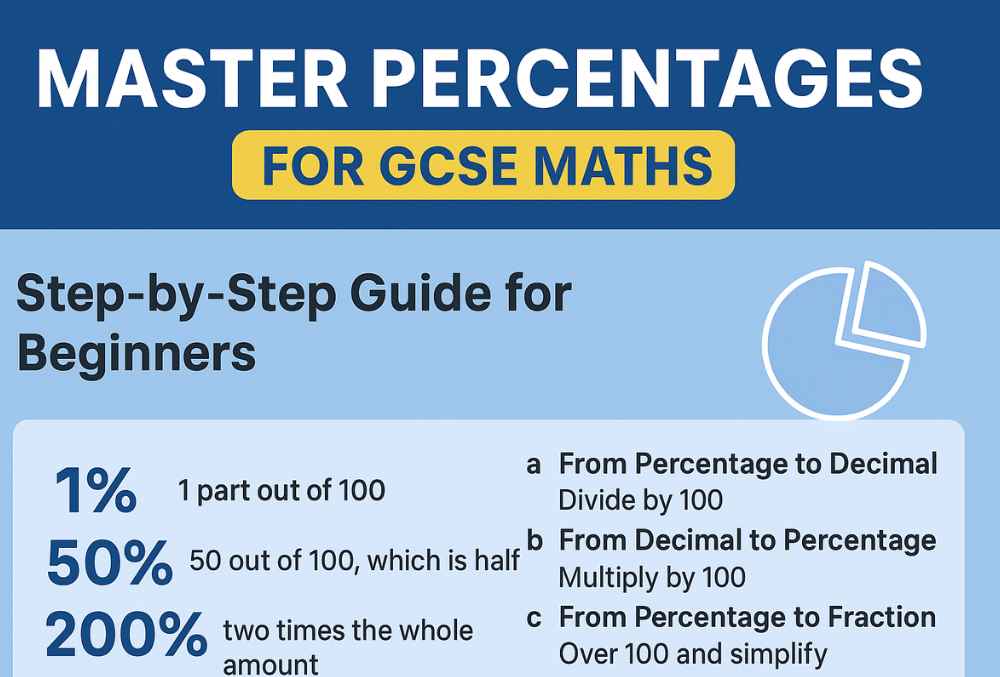Introduction
Percentages appear everywhere in daily life from shopping discounts and exam scores to bank interest rates and data charts. For GCSE Maths students, understanding percentages is essential. It’s one of the most tested topics in both Foundation and Higher Tier exams, and mastering it builds confidence for more advanced topics like ratio, proportion, and growth rates.
If you’re new to percentages or simply want to strengthen your basics, this guide will help you step by step. You’ll learn how to calculate, convert, and apply percentages, as well as how to solve typical GCSE-style questions confidently.
1. What is a Percentage?
The word percentage comes from the Latin phrase per centum, meaning “by the hundred.”
In simple terms, a percentage represents a part out of 100.
So:
- 1% means 1 part out of 100.
- 50% means 50 out of 100, which is half.
- 200% means two times the whole amount.
Percentages are just another way to express fractions and decimals.
For example:
- 25% = 25 out of 100 = one-quarter = 0.25
- 50% = 50 out of 100 = one-half = 0.5
75% = 75 out of 100 = three-quarters = 0.75
Understanding this link helps you switch between forms easily a skill often tested in GCSE questions.
2. Converting Between Percentages, Fractions, and Decimals
Being able to convert between percentages, fractions, and decimals is the foundation for all percentage questions.
Let’s go through each conversion clearly.
a) From Percentage to Decimal
Divide the percentage by 100 (or move the decimal point two places to the left).
Example:
- 25% = 0.25
- 8% = 0.08
120% = 1.20
b) From Decimal to Percentage
Multiply the decimal by 100 (move the point two places to the right).
Example:
- 0.5 = 50%
- 0.25 = 25%
1.2 = 120%
c) From Percentage to Fraction
Write the percentage over 100 and simplify it.
Example:
- 25% = 25/100 = 1/4
- 50% = 50/100 = 1/2
20% = 20/100 = 1/5
d) From Fraction to Percentage
Multiply the fraction by 100.
Example:
- 1/4 × 100 = 25%
- 3/5 × 100 = 60%
2/3 × 100 ≈ 66.67%
Keep practising these conversions until they feel natural — they’re often used in multi-step GCSE questions.
3. Finding a Percentage of an Amount
This is one of the most common types of GCSE Maths questions:
“What is x% of y?”
Method 1: The One-Percent Method
Find 1% of the amount by dividing by 100, then multiply by the required percentage.
Example: What is 14% of 250?
Step 1: 1% = 250 ÷ 100 = 2.5
Step 2: 14% = 2.5 × 14 = 35
Answer: 14% of 250 is 35.
Method 2: Build Up Using Known Percentages
Break a difficult percentage into smaller ones like 10%, 5%, and 1%.
Example: Find 23% of 400.
10% of 400 = 40
1% of 400 = 4
So 23% = (2 × 10%) + (3 × 1%) = 80 + 12 = 92
Answer: 92
Method 3: Using Fractions
If the percentage can be expressed as a simple fraction, use that.
Example:
25% of 120 = ¼ of 120 = 120 ÷ 4 = 30
50% of 80 = ½ of 80 = 40
Method 4: Using a Calculator (or Multiplier Method)
When calculators are allowed, the easiest way is to convert the percentage to a decimal and multiply.
Example: Find 17.5% of 360.
Convert 17.5% → 0.175
Multiply: 0.175 × 360 = 63
Answer: 63
This “multiplier” technique is also used in increase and decrease problems.
4. Expressing One Amount as a Percentage of Another
Another common question asks: “What percentage is A of B?”
Use this formula:
Percentage = (A ÷ B) × 100
Example 1: What percentage is 45 of 60?
45 ÷ 60 = 0.75 → ×100 = 75%
Example 2: What percentage is 25 of 120?
25 ÷ 120 = 0.2083 → ×100 = 20.83%
If your answer is above 100%, it simply means A is greater than B.
5. Percentage Increase and Decrease
Percentage change questions appear frequently in GCSE Maths, often in the context of money, sales, or population.
Percentage Increase Formula
Percentage Increase = (Increase ÷ Original) × 100
Example:
A jumper’s price rises from £40 to £50.
Increase = 10
10 ÷ 40 = 0.25 → ×100 = 25% increase
Percentage Decrease Formula
Percentage Decrease = (Decrease ÷ Original) × 100
Example:
A phone’s price drops from £600 to £450.
Decrease = 150
150 ÷ 600 = 0.25 → ×100 = 25% decrease
Shortcut: Using Multipliers
Instead of calculating increase or decrease separately, you can multiply directly using a multiplier.
- To increase by x%, multiply by (1 + x/100)
- To decrease by x%, multiply by (1 − x/100)
Example: Increase £80 by 20%.
Multiplier = 1.20 → £80 × 1.20 = £96
Example: Decrease £200 by 15%.
Multiplier = 0.85 → £200 × 0.85 = £170
This is the quickest and cleanest way to handle exam questions.
6. Reverse Percentages (Working Backwards)
Reverse percentage problems ask you to find the original amount before an increase or decrease.
a) After a Percentage Increase
Formula:
Original = Final ÷ (1 + x/100)
Example: After a 20% increase, a jacket costs £84.
Original = 84 ÷ 1.20 = £70
b) After a Percentage Decrease
Formula:
Original = Final ÷ (1 − x/100)
Example: After a 15% discount, a TV costs £170.
Original = 170 ÷ 0.85 = £200
Reverse percentage problems are common in “VAT” or “discount” contexts in GCSE exams. Always write down your multiplier carefully to avoid sign errors.
7. Real-Life Examples
Example 1: Discounts
A store offers 25% off a £160 coat.
25% of 160 = 0.25 × 160 = 40
New price = 160 − 40 = £120
Example 2: Exam Scores
A student scores 42 marks out of 60.
(42 ÷ 60) × 100 = 70%
Example 3: Price Increase
A laptop’s price goes from £500 to £575.
Increase = 75
(75 ÷ 500) × 100 = 15% increase
Example 4: Reverse Calculation
After a 10% increase, a mobile phone costs £660.
Original = 660 ÷ 1.10 = £600
Example 5: Population Growth
A town’s population increases from 12,000 to 13,200.
Change = 1,200
1,200 ÷ 12,000 = 0.1 → 10% increase
8. Common Mistakes Students Make
- Using the wrong “original” number – Always divide by the starting amount, not the new one.
- Forgetting to divide by 100 – Percentages must be converted into decimals before multiplying.
- Rounding too early – Keep full decimals until the end of the calculation.
- Mixing up “of” and “increase” – “10% of” means find a part, while “increase by 10%” means add that part.
- Ignoring context – Always ask yourself: should the result be smaller or larger than the original?
If your answer doesn’t make sense, it’s likely you’ve multiplied the wrong way around.
9. Practice Questions (Try Yourself)
- Find 18% of 250.
- Express 65 as a percentage of 200.
- A book’s price goes from £20 to £25. Find the percentage increase.
- A TV costing £900 is reduced by 30%. Find the new price.
- After a 12% increase, a shirt costs £56. Find the original price.
- A car’s value drops from £15,000 to £12,000. Find the percentage decrease.
- What is 35% of 480?
- A population increases from 45,000 to 48,600. Find the percentage increase.
Answers
- 45
- 32.5%
- 25% increase
- £630
- £50
- 20% decrease
- 168
- 8% increase
Try solving them manually first, then recheck using the multiplier method for speed.
10. Revision and Exam Strategy
- Understand, don’t memorise. Once you understand what percentages mean, every formula makes sense.
- Use the multiplier shortcut whenever you can — it saves time.
- Estimate before final answers — this helps you catch silly errors.
- Revise mixed questions that combine fractions, decimals, and percentages.
- Practise non-calculator questions — some GCSE papers still require mental or manual calculation.
- Show your working — even if your answer is wrong, clear steps can earn you partial marks.
Use past papers from Edexcel, AQA, or OCR. Focus on “Percentage Change” and “Reverse Percentages” — they’re high-frequency question types.
11. Real-World Importance of Percentages
Learning percentages isn’t just for exams. In real life, you’ll use them for:
- Calculating discounts and offers while shopping
- Understanding tax, VAT, or interest rates
- Tracking marks or scores in school and sports
- Analysing data in business or science
- Comparing performance or growth across years
So, mastering percentages helps in both everyday situations and advanced maths learning.
12. Quick Summary (GCSE Essentials)
- Percentage means “out of 100.”
- To find a percentage of something, multiply by (percentage ÷ 100).
- To express a number as a percentage of another, divide and multiply by 100.
- Use the multiplier:
- Increase → multiply by (1 + rate/100)
- Decrease → multiply by (1 − rate/100)
- Reverse percentage = final ÷ multiplier.
- Always check your answer makes sense.
13. Final Thoughts
Percentages are one of the simplest yet most powerful tools in maths. Once you understand that they’re just another way to represent fractions or decimals, everything falls into place. The key is practice — solving different types of questions until you can instantly recognise what method to apply.
Whether you’re preparing for your GCSE exams or simply improving your maths confidence, mastering percentages will help you tackle a wide range of problems with ease.


